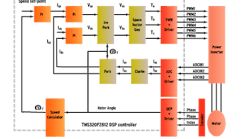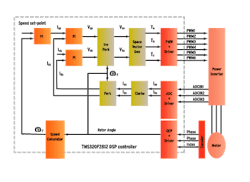It's time for us to upgrade servo motor performance from our old and tired trapezoidal commutation amps. We have to get better torque control. We hear conflicting stories about whether brushless sin/cos commutation will perform just as well as, and maybe cheaper than, the newer flux-vector solutions. We'd like to hear some user point-counterpoint on this.
--- from May 2004 Control Design
| Answers |
Lack of Standards Hinders Comparison
Sin/cos commutation or flux-vector control of brushless permanent magnet motors can provide a number of performance advantages over trapezoidal commutation. The main sinusoidal benefits are smoother low-speed torque, higher peak torques at speed, and slightly higher continuous shaft torques. The smoother low-speed torque comes from less electromagnetic torque ripple and from eliminating the step changes in currents used in trapezoidal commutation. The higher peak torques at speed provide a squarer torque speed curve that allows for faster position move times.
The difficulty in comparing sin/cos commutation and flux-vector solutions is that there is no industry standard implementation of either method, and thus the amount of benefit either solution provides over trapezoidal commutation varies depending on implementation details. Even more confusing is that some products with very advanced current control loops have all the benefits of flux-vector technology, and in fact, are very similar in details, yet are advertised simply as sinusoidal controllers.
The real way to see if you get all the benefit of these advanced technologies is to carefully examine a torque speed curve. Effective implementations will have a fairly square peak-torque speed curve and the system top speed should be very close the maximum possible without phase advance/constant power, which is the AC line voltage in rms divided by the motor line-line constant KE in Vrms/kRPM. The other way to tell is to look at the details of the current loop implementation and make sure it is described as being d-q control, stationary frame regulator or a rotate, de-rotate current controller.
To see the full performance benefit of these technologies, avoid products that have so-called stator frame current regulators,that is, products that do not mix the current regulator and the commutation into one block but instead generate a command signal (which is the desired sinusoidal current waveform in one block) and directly regulate the current in the motor to that command with a single, simple current loop.
In terms of cost, these very simple implementations of sinusoidal current control are theoretically cheaper than the higher performance ones, but, in practice, modern servo amps have been cost optimized with all digital controls and there is essentially no cost penalty between doing it right and doing it the simpler lower performance way.
George Yundt, Advanced Development Manager--Drives
Danaher Motion, www.DanaherMotion.com
Play the Field-Oriented Control
Trapezoidal commutation is a six-step method, i.e., you create six magnetic vectors in a 360? rotation. This means that the torque varies significantly as the motor turns. The downside is that you end up with torque ripple. To the user, this means that the servo gain changes from point to point and it is harder to use in high-performance systems.
What is happening under the hood is that the commutation amplifier is presenting the speed and position control loops (typical outer loops) with a angle-varying gain, which is a non-linear function. This means that to avoid problems, you must back off the controller setting.
Using a less aggressive outer position or speed regulator means that you sacrifice performance, simply because the commutation scheme is not using the motor to its maximum potential.
A first approximation to solving this issue is to create a magnetic vector that moves continuously along with the rotor. (as opposed to once every 60 degrees). This produces less torque ripple, and, since the rotor and stator magnetic flux vectors are optimally aligned, produces the most torque per ampere input in to the motor.
A simple sine modulation scheme does not achieve this: When the motor moves rapidly, the currents will increasingly lag the applied voltages. This means that the flux alignment is non-optimal, and results in significant performance deterioration at higher speeds (Figure 1).
Figure 1: Sine Modulation
Flux relationships in a motor and torque in a motor. Simple modulation doesn't optimally align rotor and stator magnetic flux vectors. This results in performance deterioration at higher.
There is another problem: The outer control loop must then dump more current into the motor to get the same torque, the end result is increased motor heating.
Field-Oriented Control
In a Field-Oriented Control Scheme, the idea is to maintain this optimal relationship between the rotor and stator flux to produce the maximum torque output for a given stator flux. The stator flux then is controlled by varying the drive currents to generate the commanded torque.
An important consideration is the placement of the current controllers. Placing the controllers in the stator reference frame is an unsatisfactory proposition, since you are asking the controllers to regulate a sinusoidal quantity. Placing the controllers in a rotor flux referenced frame, i.e., stationary with respect to the rotating rotor flux, removes the sinusoidal modulation. The PI controllers can control these DC signals much more effectively.
Such a control scheme is shown in Figure 2. The controllers performing the current control are on the left side of the transforms, which perform the transformation from the stationary to the rotating reference frames.
Figure 2: DSP Controller
Field-Oriented Control for a permenent magnet syncronius motor (PMSM) servo maintains an optimal relationship between the rotor and stator flux to produce maximum torque for a given stator flux.
The historical downside with this approach has been that the computations to transform the currents from the stator to the rotor reference frame are numerically intensive and will swamp a microprocessor or a RISC processor. There needs to be a numerically capable controller that implements these computations. Numerical ability traditionally has come with a high price tag, and without the peripheral configuration or the form factor suitable for a embedded system such as a servo drive.
Does FOC Have to Cost More?
No, it doesn't. So what has changed? A new breed of controllers--digital signal processor (DSP)-based controllers are enabling drive manufacturers to design drives with field-oriented control and more. At prices from $2-$15, these DSP controllers come with very-powerful number crunching cores, from 16-bit, 40 MIPS controllers to 32-bit, 150 MIPS. Also, these DSP controllers are designed with key motor control peripherals on chip. Fast interrupt response, and special op-codes for common control tasks such as bit manipulation, make these devices suitable for use in embedded hard-real-time environments. On-chip features include Flash memory, analog-to-digital converters (ADCs), pulse-width modulated (PWM) outputs and CANbus support.
This makes it possible for the drive designer to innovate, within the (small) form factors that are becoming customary. What this means to the end user is a field-oriented control drive that is smaller than the trapezoidal commutation drive it replaces, and has better efficiency and higher performance at the same time. Servo drive manufacturers are also using that processing power to add more features such as power factor correction (PFC).
As a side note, replacing the older trapezoidal drives with more modern technology, means that the user gets the benefit of the added features such as PFC--this can solve problems other than the improvement in commutation performance.
Kedar Godbole, Motor Control Strategist
Texas Instruments
| November's Problem |
Is Thin-Client the Answer?
We'll be responding soon to an RFQ to supply updated operator terminals and control stations for a train of industrial machines. The customer wants the ability to present multiple applications and multiple-machine monitoring simultaneously and provide on-site monitoring and diagnostics that includes interactive maintenance files and even video and audio. We think we should pursue a thin-client approach. Any advice?
Send us your comments, suggestions, or solutions for these problems. We'll include them in the November 2004 issue. Send visuals, too,a sketch is fine E-mail us at [email protected] or mail to The Answer to Your Problems, CONTROL DESIGN, 555 W. Pierce Rd., Suite 301, Itasca, IL 60143. You can also fax to 630/467-1124. Please include your company, location and title in the response.
Have a problem you'd like to pose to the readers? Send it along, too.

Leaders relevant to this article:





